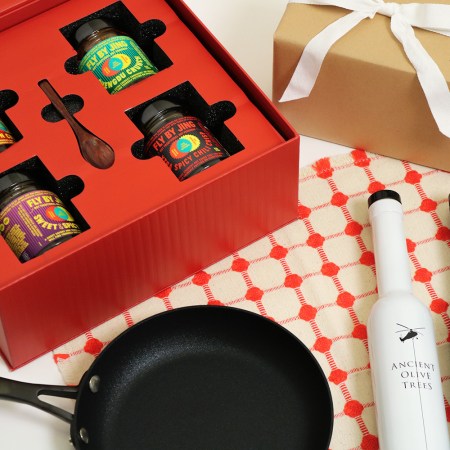Salt has long been an essential commodity, used not just to season food but to preserve it to last through long winters. It was so valuable in ancient times, it was even sometimes used to pay Roman soldiers, paving the way for the modern word “salary.” Unsurprisingly, in pro kitchens around the world, chefs take their salts very seriously.
Celebrity chef Andrew Zimmern has “eight or nine” salts on-hand at all times, and that’s not counting his plentiful selection of infused salts, which pushes the final count to 20 or more. “I have some salt from the Lac Rose in Senegal,” he says. “I have herb-infused salts from the Grenadines. I have a homemade charred rosemary salt that I’m very fond of, especially for summertime grilling. I have some finely ground Sicilian sea salt and a couple of Japanese sea salts. And they all have different flavors. They all have different salinities. I use them for different things.”
Of course, not all chefs are as maximalist with the sheer quantity of salts they keep around. Jon Kung, author of Kung Food: Chinese American Recipes from a Third Culture Kitchen, generally has three salts on-hand at all times, including “a high-quality Chinese light soy sauce.”
Chef Chris Edwards of Café des Musiciens in Nice, France, also relies on a big three: “sel gris, sel fin broyé and fleur de sel. All have their use and place,” he says.
Finishing salts are the most divisive, and that’s not surprising. These salts are the first ones a diner encounters, and they often leave the most lasting impression. They’re also gaining popularity in a world where, according to chef Julien Allano of fine dining restaurant Ju Maison de Cuisine in southern French Bonnieux, “there’s a trend of salting less, as compared to when I started out.”
For many, the crème de la crème of finishing salts is flaky French fleur de sel, which mainly hails from Brittany, where it naturally forms on the surface of shallow pools of seawater and is then painstakingly skimmed off by hand. Moist and richly flavorful with a distinctive crunch, fleur de sel is particularly well-suited to delicate vegetables and salads, according to Max Chodorow of New York’s Jean’s. Chef Jeremy Ford of Miami’s Michelin-starred Stubborn Seed loves using it on fish. His preferred brand is Le Guerandais, whose delicate crystals are naturally snowy in color, despite being sold unwashed and uncrushed.
But fleur de sel is not the only finishing salt top chefs love. Hand-harvested Cornish Sea Salt is known for its moist, chunky texture and nuanced, mineral-rich flavor, which grants it a spot in Kung’s culinary arsenal. Still, others look to eastern England, where Maldon salt’s distinctive pyramid shape lends an inimitable texture, according to chef Maxime Bouttier of Michelin-starred Géosmine in Paris.

“For me, fleur de sel is a bit too round and a bit too breakable,” Bouttier says, noting that it has a tendency to fall off the “firm, vegetal surface” of products like green beans. Maldon, on the contrary, “is a bit more flat and vertical than round fleur de sel.” This, compounded with its lower salinity, makes it Bouttier’s go-to.
Chodorow keeps both Maldon and fleur de sel in his kitchen, noting he prefers the former for “crudos and other one-bite things.”
Ford, too, uses both. “Maldon is for meat and fleur is for fish,” he says, noting nevertheless that if he had to pick only one, it would “definitely be Maldon! It’s the ultimate salt!”
But its unique texture isn’t enough to convince Allano to use this English salt in his southern French kitchen. “I’ve toyed with Maldon salt, but I have a hard time bringing salt from so far away,” he says.
Chef Govind Armstrong on the Strangest Things He’s Ever Grilled, Including Beaver Tail
Plus: An oxtail recipe for the ambitious home chefTerroir is indeed a major motivator for some in selecting their salts. Scandinavian chefs were quickly converted by the 2011 launch of Saltverk, an Icelandic salt company founded by Björn Steinar Jónsson that takes full advantage of hot geysers for a hand-harvested, zero carbon product that has graced the kitchens of such chefs as Matt Orlando of Copenhagen’s BÆST or Gunnar Karl Gíslasson’s Dill, Iceland’s first Michelin-starred restaurant. Edwards, too, keeps local terroir front-of-mind when considering which salt to use. “We use Esprit du Sel because of their traditional and respectful methods and the pure quality of the salt,” he says. “They also sell directly, and I love to have these types of relations with our producers.”
Allano, meanwhile, opts for local, hand-raked gray salt from Les Sauniers de Camargue, and not just for his finishing salt. “I don’t work with fine white salt that’s been treated with all sorts of anti-caking agents and has – sorry for the word – all kinds of shit in it,” he says. He takes advantage of the company’s unrefined fine and coarse salts as well, which don’t just have more flavor but also work far better for fermentation than salts of the refined variety.
Chef Shingo Akikuni of Miami’s SHINGO uses two Japanese salts in his kitchen: one from Ishikawa prefecture for his otoro tuna and another from Okinawa as his all-arounder. “It has a great mineral quality, and it adds a unique flavor — not just saltiness — to my cooking,” he says.
Tim Hardiman, VP of Food & Beverage at Tailor & the Cook, a farm-to-table restaurant in Utica, NY, sources from Syracuse Salt, a family-run company that’s hand-harvesting salt from natural brine wells deep below the shores of Lake Onondaga. The coarse, flaky salt boasts a robust flavor that Hardiman loves for its consistency, which he dubs “part of its charm.”
But the be-all and end-all for most of our chefs is none other than that tried-and-true kitchen workhorse: kosher salt. This large-grain salt gets its name from its connection to the koshering process, whereby Jewish cooks would use it to dry-brine meat and remove surface blood. The larger crystal size dissolves more slowly, brining meat more evenly. But for chefs, it also paves the way for easier, more consistent seasoning.
Within the greater category of kosher salt, two brands are at odds: Morton and Diamond Crystal. And pro chefs have a resounding preference for the latter. “It has slightly larger crystals, which makes it great for seasoning and curing, especially meats,” says Mary Attea, Executive Chef of Raf’s New York. “It’s also less refined, so it doesn’t contain additives such as anti-caking agents.”
It’s no surprise that chefs like Kung and Zimmern would, if pushed to choose, pick kosher as their desert island salt. “I use it the most,” Kung says. “Granted I’m not counting soy sauce in this because I don’t want to put myself through that kind of mental anguish.”
Zimmern agrees. “If I could only have one salt for the rest of my life, I’d have to go kosher because I can use it for everything,” he says.
Join America's Fastest Growing Spirits Newsletter THE SPILL. Unlock all the reviews, recipes and revelry — and get 15% off award-winning La Tierra de Acre Mezcal.

























